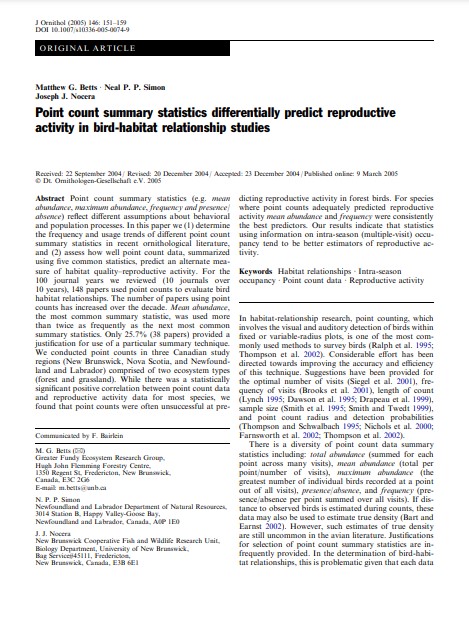Point count summary statistics differentially predict reproductive activity in bird-habitat relationship studies
Bosque Modelo:
Fundy
Temática:
Gestión forestal
Tipo de documento:
Artículo científico
Resumen
Point count summary statistics (e.g. mean abundance, maximum abundance, frequency and presence/absence) reflect different assumptions about behavioral and population processes. In this paper we (1) determine the frequency and usage trends of different point count summary statistics in recent ornithological literature, and (2) assess how well point count data, summarized using five common statistics, predict an alternate measure of habitat quality–reproductive activity. For the 100 journal years we reviewed (10 journals over 10 years), 148 papers used point counts to evaluate bird habitat relationships. The number of papers using point counts has increased over the decade. Mean abundance, the most common summary statistic, was used more than twice as frequently as the next most common summary statistics. Only 25.7% (38 papers) provided a justification for use of a particular summary technique. We conducted point counts in three Canadian study regions (New Brunswick, Nova Scotia, and Newfoundland and Labrador) comprised of two ecosystem types (forest and grassland). While there was a statistically significant positive correlation between point count data and reproductive activity data for most species, we found that point counts were often unsuccessful at predicting reproductive activity in forest birds. For species where point counts adequately predicted reproductive activity mean abundance and frequency were consistently the best predictors. Our results indicate that statistics using information on intra-season (multiple-visit) occupancy tend to be better estimators of reproductive activity.
Información Bibliográfica
Autor:
Betts, MG, Simon, NPP and JJ Nocera.
Revista:
Journal of Ornithology
Año:
2005
N°:
-
País :
Canadá
Páginas:
151 - 159
Volumen:
146
Idioma:
Ingles
Palabras claves
Habitat relationships, Intra-season occupancy, Point count data, Reproductive activity





